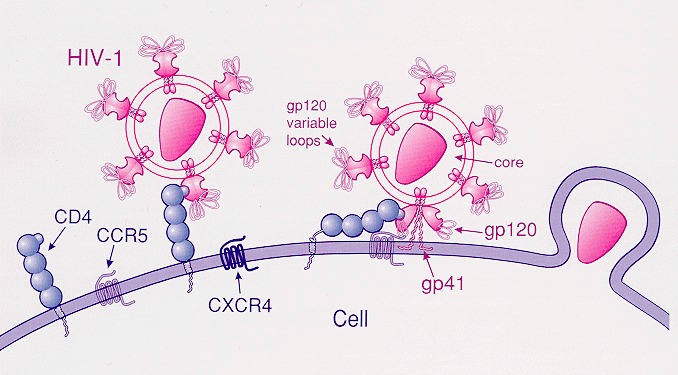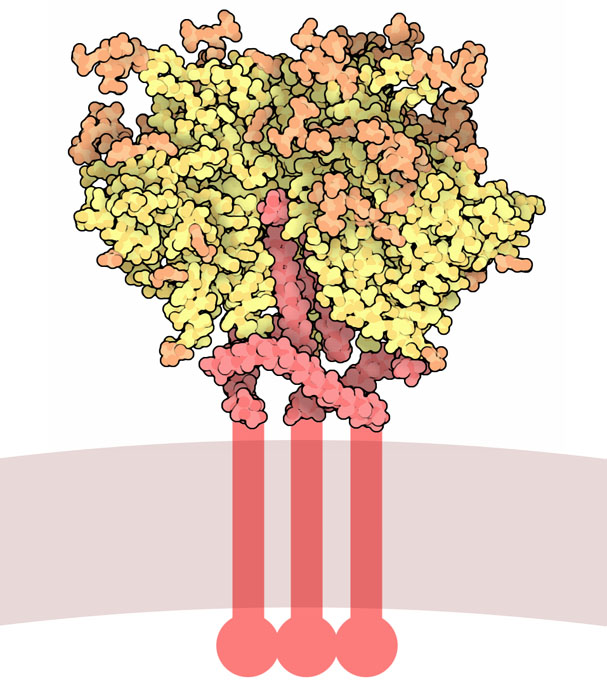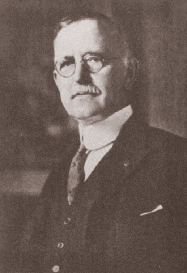|
PRO 140
Leronlimab (codenamed PRO 140) is a humanized monoclonal antibody targeted against the CCR5 receptor found on T lymphocytes of the human immune system. It is being investigated as a potential therapy in the treatment of COVID-19, triple negative breast cancer, and HIV infection. The United States Food and Drug Administration has designated PRO 140 for fast-track approval. In February 2008, the drug entered Phase 2 clinical trials and a phase 3 trial was begun in 2015. In February 2018, Cytodyn Inc reported that the primary endpoint had been achieved in the PRO 140 pivotal combination therapy trial in HIV infection. In 2020 CytoDyn submitted a fast-track biologics license application for treatment of CCR5-tropic HIV-1 Infection. Development PRO 140 is being developed by Cytodyn Inc. In May 2007, results from the phase I clinical trial of the drug demonstrated "potent, rapid, prolonged, dose-dependent, highly significant antiviral activity" for PRO 140. Participants in the high ... [...More Info...] [...Related Items...] OR: [Wikipedia] [Google] [Baidu] |
CCR5
C-C chemokine receptor type 5, also known as CCR5 or CD195, is a protein on the surface of white blood cells that is involved in the immune system as it acts as a receptor for chemokines. In humans, the ''CCR5'' gene that encodes the CCR5 protein is located on the short (p) arm at position 21 on chromosome 3. Certain populations have inherited the ''Delta 32'' mutation, resulting in the genetic deletion of a portion of the CCR5 gene. Homozygous carriers of this mutation are resistant to M-tropic strains of HIV-1 infection. Function The CCR5 protein belongs to the beta chemokine receptors family of integral membrane proteins. It is a G protein–coupled receptor which functions as a chemokine receptor in the CC chemokine group. CCR5's cognate ligands include CCL3, CCL4 (also known as MIP 1''α'' and 1''β'', respectively), and CCL3L1. CCR5 furthermore interacts with CCL5 (a chemotactic cytokine protein also known as RANTES). CCR5 is predominantly expressed on T cells, ... [...More Info...] [...Related Items...] OR: [Wikipedia] [Google] [Baidu] |
Prostate Cancer
Prostate cancer is cancer of the prostate. Prostate cancer is the second most common cancerous tumor worldwide and is the fifth leading cause of cancer-related mortality among men. The prostate is a gland in the male reproductive system that surrounds the urethra just below the bladder. It is located in the hypogastric region of the abdomen. To give an idea of where it is located, the bladder is superior to the prostate gland as shown in the image The rectum is posterior in perspective to the prostate gland and the ischial tuberosity of the pelvic bone is inferior. Only those who have male reproductive organs are able to get prostate cancer. Most prostate cancers are slow growing. Cancerous cells may spread to other areas of the body, particularly the bones and lymph nodes. It may initially cause no symptoms. In later stages, symptoms include pain or difficulty urinating, blood in the urine, or pain in the pelvis or back. Benign prostatic hyperplasia may produce similar symptoms ... [...More Info...] [...Related Items...] OR: [Wikipedia] [Google] [Baidu] |
Allosteric
In biochemistry, allosteric regulation (or allosteric control) is the regulation of an enzyme by binding an effector molecule at a site other than the enzyme's active site. The site to which the effector binds is termed the ''allosteric site'' or ''regulatory site''. Allosteric sites allow effectors to bind to the protein, often resulting in a conformational change and/or a change in protein dynamics. Effectors that enhance the protein's activity are referred to as ''allosteric activators'', whereas those that decrease the protein's activity are called ''allosteric inhibitors''. Allosteric regulations are a natural example of control loops, such as feedback from downstream products or feedforward from upstream substrates. Long-range allostery is especially important in cell signaling. Allosteric regulation is also particularly important in the cell's ability to adjust enzyme activity. The term ''allostery'' comes from the Ancient Greek ''allos'' (), "other", and ''stereos' ... [...More Info...] [...Related Items...] OR: [Wikipedia] [Google] [Baidu] |
Gp41
Gp41 also known as glycoprotein 41 is a subunit of the envelope protein complex of retroviruses, including human immunodeficiency virus (HIV). Gp41 is a transmembrane protein that contains several sites within its ectodomain that are required for infection of host cells. As a result of its importance in host cell infection, it has also received much attention as a potential target for HIV vaccines. Gene and post-translational modifications Gp41 is coded with gp120 as one gp160 by the ''env'' gene of HIV. Gp160 is then extensively glycosylated and proteolytically cleaved by furin, a host cellular protease. The high glycosylation of the env coded glycoproteins allows them to escape the human body's immune system. In contrast to gp120, however, gp41 is less glycosylated and more conserved (less prone to genetic variations). Once gp160 has been cleaved into its individual subunits, the subunits are then associated non-covalently on the surface of the viral envelope. Structur ... [...More Info...] [...Related Items...] OR: [Wikipedia] [Google] [Baidu] |
Gp120
Envelope glycoprotein GP120 (or gp120) is a glycoprotein exposed on the surface of the HIV envelope. It was discovered by Professors Tun-Hou Lee and Myron "Max" Essex of the Harvard School of Public Health in 1988. The 120 in its name comes from its molecular weight of 120 kDa. Gp120 is essential for virus entry into cells as it plays a vital role in attachment to specific cell surface receptors. These receptors are DC-SIGN, Heparan Sulfate Proteoglycan and a specific interaction with the CD4 receptor, particularly on helper T-cells. Binding to CD4 induces the start of a cascade of conformational changes in gp120 and gp41 that lead to the fusion of the viral membrane with the host cell membrane. Binding to CD4 is mainly electrostatic although there are van der Waals interactions and hydrogen bonds. Gp120 is coded by the HIV ''env'' gene, which is around 2.5 kb long and codes for around 850 amino acids.Kuiken, C., Leitner, T., Foley, B., ''et al.'' (2008)"HIV Sequence Compe ... [...More Info...] [...Related Items...] OR: [Wikipedia] [Google] [Baidu] |
Entry Inhibitor
Entry inhibitors, also known as fusion inhibitors, are a class of antiviral drugs that prevent a virus from entering a cell, for example, by blocking a receptor. Entry inhibitors are used to treat conditions such as HIV and hepatitis D. HIV entry They are used in combination therapy for the treatment of HIV infection. This class of drugs interferes with the binding, fusion and entry of an HIV virion to a human cell. By blocking this step in HIV's replication cycle, such agents slow the progression from HIV infection to AIDS. Proteins There are several key proteins involved in the HIV entry process. * CD4, a protein receptor found on the surface of helper T cells in the human immune system, also called CD4+ T cells * gp120, a protein on HIV surface that binds to the CD4 receptor * CCR5, a second receptor found on the surface of CD4+ cells and macrophages, called a chemokine co-receptor * CXCR4, another chemokine co-receptor found on CD4+ cells * gp41, a HIV protein, close ... [...More Info...] [...Related Items...] OR: [Wikipedia] [Google] [Baidu] |
Joseph Estrada
Joseph Ejercito Estrada, (; born Jose Marcelo Ejercito; April 19, 1937), also known by the nickname Erap, is a Filipino politician and former actor. He served as the 13th president of the Philippines from 1998 to 2001, the 9th vice president of the Philippines from 1992 to 1998, and the 21st mayor of the City of Manila, the country's capital, from 2013 to 2019. In 2001, he became the first chief executive in Asia to be formally impeached and resigned from power. At the age of 85, he is currently the oldest living former Philippine President. Estrada gained popularity as a film actor, playing the lead role in over a hundred films in an acting career spanning some three decades. He also worked as a model, beginning as a fashion and ramp model at the age of 13. He used his popularity as an actor to make gains in politics, serving as mayor of San Juan from 1969 to 1986, as senator from 1987 to 1992, then as vice president under President Fidel V. Ramos from 1992 to 1998. Estr ... [...More Info...] [...Related Items...] OR: [Wikipedia] [Google] [Baidu] |
Cleveland Clinic
Cleveland Clinic is a nonprofit American academic medical center based in Cleveland, Ohio. Owned and operated by the Cleveland Clinic Foundation, an Ohio nonprofit corporation established in 1921, it runs a 170-acre (69 ha) campus in Cleveland, as well as 11 affiliated hospitals, 19 family health centers in Northeast Ohio, and hospitals in Florida and Nevada. International operations include the Cleveland Clinic Abu Dhabi hospital in the United Arab Emirates and Cleveland Clinic Canada, which has two executive health and sports medicine clinics in Toronto."Facts & Figures" Cleveland Clinic. Another hospital campus in the United Kingdom, Cleveland Clinic London, opened to outpatients in 2021 and is scheduled to fully open in 2022. Tomislav Mihaljevic is the president and CEO. Cleveland Cl ... [...More Info...] [...Related Items...] OR: [Wikipedia] [Google] [Baidu] |
Nonalcoholic Steatohepatitis
Non-alcoholic fatty liver disease (NAFLD), also known as metabolic (dysfunction) associated fatty liver disease (MAFLD), is excessive fat build-up in the liver without another clear cause such as alcohol use. There are two types; non-alcoholic fatty liver (NAFL) and non-alcoholic steatohepatitis (NASH), with the latter also including liver inflammation. Non-alcoholic fatty liver is less dangerous than NASH and usually does not progress to NASH. When NAFL does progress to NASH, it may eventually lead to complications such as cirrhosis, liver cancer, liver failure, or cardiovascular disease. Obesity and type 2 diabetes are strong risk factors for NAFLD. Other risks include being overweight, metabolic syndrome (defined as at least three of the five following medical conditions: abdominal obesity, high blood pressure, high blood sugar, high serum triglycerides, and low serum HDL cholesterol), a diet high in fructose, and older age. NAFLD and alcoholic liver disease are typ ... [...More Info...] [...Related Items...] OR: [Wikipedia] [Google] [Baidu] |
Carboplatin
Carboplatin, sold under the trade name Paraplatin among others, is a chemotherapy medication used to treat a number of forms of cancer. This includes ovarian cancer, lung cancer, head and neck cancer, brain cancer, and neuroblastoma. It is used by injection into a vein. Side effects generally occur. Common side effects include low blood cell levels, nausea, and electrolyte problems. Other serious side effects include allergic reactions and increased future risk of another cancer. Use during pregnancy may result in harm to the baby. Carboplatin is in the platinum-based antineoplastic family of medications and works by interfering with duplication of DNA. Carboplatin was patented in 1972 and approved for medical use in 1989. It is on the World Health Organization's List of Essential Medicines. Medical uses Carboplatin is used to treat a number of forms of cancer. This includes ovarian cancer, lung cancer, head and neck cancer, brain cancer, and neuroblastoma. It may be used fo ... [...More Info...] [...Related Items...] OR: [Wikipedia] [Google] [Baidu] |
Triple-negative Breast Cancer
Triple-negative breast cancer (TNBC) is any breast cancer that lacks or show low levels of estrogen receptor (ER), progesterone receptor (PR) and human epidermal growth factor receptor 2 (HER2) overexpression and/or gene amplification (i.e. the tumor is negative on all three tests giving the name ''triple-negative''). Triple-negative is sometimes used as a surrogate term for basal-like. Triple-negative breast cancer comprises 15–20% of all breast cancer cases and affects more young women or women with a mutation in the BRCA1 gene than other breast cancers. Triple-negative breast cancers comprise a very heterogeneous group of cancers. TNBC is the most challenging breast cancer type to treat. Hormone therapy that is used for other breast cancers does not work for TNBC. In its early stages, the cancer is typically treated through surgery, radiation and chemotherapy. In later stages where surgery is not possible or the cancer has spread from the initial localised area, treatment i ... [...More Info...] [...Related Items...] OR: [Wikipedia] [Google] [Baidu] |
Stomach Cancer
Stomach cancer, also known as gastric cancer, is a cancer that develops from the lining of the stomach. Most cases of stomach cancers are gastric carcinomas, which can be divided into a number of subtypes, including gastric adenocarcinomas. Lymphomas and mesenchymal tumors may also develop in the stomach. Early symptoms may include heartburn, upper abdominal pain, nausea, and loss of appetite. Later signs and symptoms may include weight loss, yellowing of the skin and whites of the eyes, vomiting, difficulty swallowing, and blood in the stool, among others. The cancer may spread from the stomach to other parts of the body, particularly the liver, lungs, bones, lining of the abdomen, and lymph nodes. The most common cause is infection by the bacterium ''Helicobacter pylori'', which accounts for more than 60% of cases. Certain types of ''H. pylori'' have greater risks than others. Smoking, dietary factors such as pickled vegetables and obesity are other risk factors. About 10% ... [...More Info...] [...Related Items...] OR: [Wikipedia] [Google] [Baidu] |





